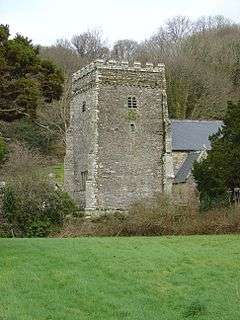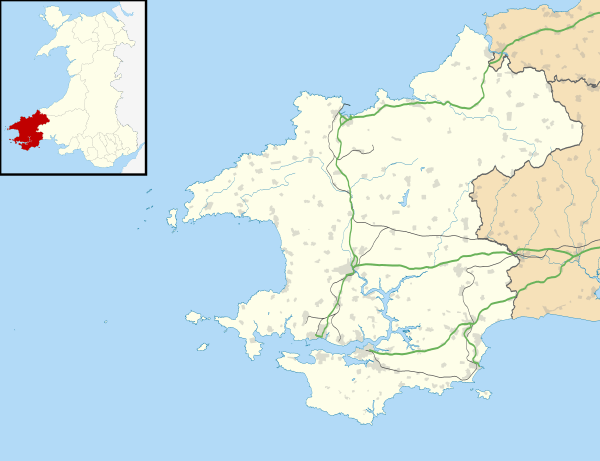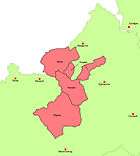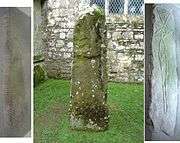Nevern
| Nevern | |
| Welsh: Nanyfer | |
 St Brynach's Church |
|
 Nevern |
|
| Population | 865 (2011)[1] |
|---|---|
| OS grid reference | SN082400 |
| Community | Nevern |
| Principal area | Pembrokeshire |
| Country | Wales |
| Sovereign state | United Kingdom |
| Post town | Newport |
| Postcode district | SA42 0 |
| Dialling code | 01239 |
| Police | Dyfed-Powys |
| Fire | Mid and West Wales |
| Ambulance | Welsh |
| EU Parliament | Wales |
| UK Parliament | Preseli Pembrokeshire |
| Welsh Assembly | Preseli Pembrokeshire |
|
|
Coordinates: 52°01′N 4°48′W / 52.02°N 4.80°W
Nevern (Welsh: Nanhyfer) is a parish, community and small village in Pembrokeshire, West Wales. The community includes the settlements of Felindre Farchog, Monington, Moylgrove and Bayvil. Nevern lies in the valley of the River Nevern close to the Preseli Hills of the Pembrokeshire Coast National Park 2 miles (3 km) east of Newport on the B4582 road.
History
Castle
The castle was located on a spur of the hill 150 m northwest of the church. Little remains of it. It was the original headquarters of the Normans in the Marcher lordship of Cemais, built on the hill above the village by Robert fitz Martin around 1108. The castle was destroyed and Robert expelled during the rebellion of 1136. His son, William fitz Martin, regained both Nevern and Cemais via a marriage to a daughter of Rhys ap Gruffydd but was in turn driven out by Rhys about 1189. In 1197 William founded the nearby town of Newport, and transferred the headquarters of the Lordship to Newport castle. Nevern castle then ceased to be important.
Nevern was a marcher borough. George Owen, in 1603, described it as one of nine Pembrokeshire "boroughs in decay".[2]
Dyfed Archaeological Trust has carried out excavations at the castle site.[3]
Bridge
Nevern Bridge spans the River Nevern in the centre of the village. The current bridge was built in the late 18th or early 19th century and is Grade II listed. It has two unequal arches, recessed with keystones.[4]
Parish

The parish of Nevern was the largest in Pembrokeshire at 5,963 hectares (14,730 acres), and was divided into four "quarters": Crugiau, Morfa, Trewern and Cilgwyn. Cilgwyn extends to the far side of the Preseli Hills. The church is in Crugiau Quarter.
In 1833 the population of the parish, at 1,558 inhabitants, was nearly twice that of 2011.[5]
Parish Church
The Norman church of St Brynach is on the site of St Brynach's 6th century "clas", an important ecclesiastical centre. At the time when it is said that Dyfed had seven bishops, this was probably the seat of one. Except for the castellated tower, perilously undercut by the adjacent river Caman, most of the original Norman structure of the present building has been rebuilt. The church and churchyard are remarkable for the Celtic Cross and several inscribed stones.
George Owen is buried here, and he is commemorated by a plaque in the Henllys Chapel behind the organ.
In the churchyard is a "bleeding yew" that leaks red sap at certain times of the year.[6]
Ancient remains


The Nevern Cross on the south side of the church dates from the 10th century or early 11th century. It consists of two sections fitted together with a mortice and tenon joint, both cut from the local dolerite stone. It has classic braided decorations and inscriptions reading "dns" on one side and "h.an.eh" on the other.
Nearby is the Vitalianus Stone, dating from around 500 AD, inscribed in Latin "VITALIANI EMERTO" and in Ogham "vitaliani".
In the Trewern Chapel in the south transept, two inscribed stones are set into the window sills. The Maglocunus Stone is inscribed in Latin "MAGLOCUNI FILI CLUTORI" and in Ogham "maglicunas maqi clutar.." and is of the 5th century or early 6th century. The Braided Cross is of the early 10th century.
There is a Pilgrim's Cross cut into the rock on the roadside between the village and the castle.
The Pentre Ifan cromlech and the Castell Henllys hillfort are in the parish, each about 2 miles from Nevern village as the crow flies. Nevern is slightly more than 2 miles from the small town of Newport.
References
- ↑ "Constituency population 2011". Retrieved 21 April 2015.
- ↑ Owen, George, The Description of Penbrokshire by George Owen of Henllys Lord of Kemes, Henry Owen (Ed), London, 1892
- ↑ "Dyfed Archaeological Trust: Nevern Castle Project". Retrieved 23 March 2016.
- ↑ "British Listed Buildings". Retrieved 23 March 2016.
- ↑ "GENUKI: Nevern". Retrieved 23 March 2016.
- ↑ "Pembrokeshire Virtual Museum: St Brynach's Church (Nevern)". Retrieved 23 March 2016.
Sources
Dillwyn Miles, A Book on Nevern, Gomer, 1998, ISBN 1-85902-578-1
External links
- Nevern Castle - official site
- Article on Nevern Village, Church and Castle
- Map sources for Nevern
- Historical information and sources on GENUKI
- Photographs of Nevern and surrounding area on Geograph
